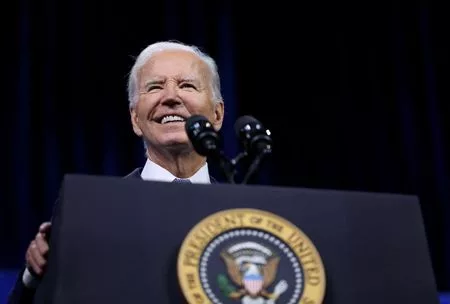By Nandita Bose, Jarrett Renshaw and Stephanie Kelly
LAS VEGAS/WASHINGTON (Reuters) – U.S. President Joe Biden’s campaign is pursuing a razor-thin path to reelection against his Republican opponent Donald Trump in November, senior Democratic officials say, with four of the seven key battleground states now looking increasingly out of reach.
Georgia, Arizona and Nevada — all claimed by Biden in 2020 – in addition to North Carolina which Democrats had hoped at one point to take back from Trump have grown more challenging, more than a dozen campaign officials and senior Democrats in battleground states told Reuters in interviews.
Trump, 78, had been leading the polls in all four states well before he was grazed by a bullet last weekend, a position that consolidated after Biden’s disastrous debate performance on June 27.
Calculations can change before election day. But the campaign officials’ latest assessment allows for almost no margin of error. Biden, 81, can only cobble together the 270 Electoral College votes needed to clinch the presidency if he wins the Rust Belt manufacturing states of Pennsylvania, Wisconsin and Michigan and a congressional district in Nebraska that could also soon be at risk.
“It’s looking very tight” in Arizona, Georgia and Nevada, a senior campaign official told Reuters. “Michigan, Pennsylvania, Wisconsin is the clearest path to 270. That is what we’re focusing on.”
However, Dan Kanninen, the director for battleground states, said the campaign was adding staff in Arizona and Nevada and that being “highly competitive” in all of the swing states remained a priority. “I do not see the map narrowing for us,” he said in an interview.
Biden was on the second day of a two-day trip to Nevada on Wednesday, when the White House announced he had a mild case of COVID and had canceled a planned speech.
Democratic lawmakers have voiced fears that Biden would lose not only the White House but also the House of Representatives and Senate to the Republican party.
The campaign had hoped those voices would quiet after the shooting. But U.S. Representative Adam Schiff, a California Democrat who is running for the Senate, warned donors in a private meeting Tuesday that the party was likely to suffer major losses if Biden continued to run.
Trump’s immediate, televised reaction to the shooting — a raised fist as blood streamed down his face from a grazed ear — contrasted with questions over Biden’s mental acuity and whether he has the stamina for four more years in the White House.
Although most polls show Biden lagging Trump in the Rust Belt states the campaign is focused on, the Democratic candidate remains “within the margin of error,” the senior official noted.
“This is the strongest path, one we’re focused on right now,” the official added.
The narrowing map for Biden means a widening one for Trump. Some polls before the shooting showed Trump competitive in Democratic-leaning Virginia, New Hampshire and even Minnesota, which hasn’t supported a Republican presidential candidate since 1972.
“When things go south, they go south everywhere,” James Carville, a veteran Democratic strategist, said. “This has been the worst summer for a national party since Republicans and Watergate,” he added, referring to the Congressional investigation that resulted in Republican President Richard Nixon’s resignation in 1974.
‘BEST CASE’ COULD JUST EKE OUT A WIN
Biden beat Trump in 2020 in the popular vote by seven million votes and racked up 306 votes in the electoral college to Trump’s 232, with support from suburbs and the well-to-do in the Rust Belt states and the Sun Belt of Arizona and Nevada, as well as a rush of young voters after a summer of protests for racial justice and civil rights.
Since the November 2020 election, Biden pumped federal money into infrastructure and manufacturing, while overseeing a post-COVID economy that grew faster than other nations, but hit inflation highs. His support for Israel’s assault on Gaza after the attacks by Hamas, which have killed over 37,000 Palestinians, has splintered the coalition that elected him.
Battleground state polls have favored Trump for months, and particularly since the debate in which Biden stumbled and struggled to complete sentences, while Trump repeated a series of well-worn falsehoods. None have been published since the shooting, but the assassination attempt has increased enthusiasm for Trump among his fans, which could boost Republican turnout.
Biden “would have to draw an inside straight without missing a single potential electoral vote in order to just scrape over the finish line of 270,” said Republican pollster Whit Ayres, referring to a tough poker hand.
U.S. presidential elections in recent years have been decided by a narrow slice of voters in a handful of states, but the new map for Biden – if successful – would eke out a victory with just 270 electoral college votes to Trump’s 268, the narrowest victory since Republican Rutherford B. Hayes won by one electoral college vote in 1876.
Nebraska is one of two states which splits their electoral college votes. (Maine is the other).
Biden won the congressional district which includes Omaha in 2020, but Republicans, who are in control of the state, are expected to hold a special session later this month to make Nebraska a winner-take-all election. That would block Biden from a single, clinching electoral vote – and could create an unprecedented 269-269 tie vote.
‘POLL-ERCOASTER’
While some Democrats see a narrower map, many strategists and state party officials say they remain optimistic about wider wins against Trump.
Since 2020, they point out, Trump and his allies sued unsuccessfully to overturn the election results; his followers attacked the U.S. Capitol on Jan. 6, 2021; a jury found him guilty of sexual abuse and he was convicted of multiple felonies over hush payment to a porn star.
“They’re not any independent Democratic voters who looked at Donald Trump get shot in the ear and say, ‘Oh my god, I gotta vote for this guy,’” said Bakari Sellers, a Democratic political analyst. “There’s no such thing as a sympathy vote in the United States of America.”
The campaign is spending $50 million on paid media in battleground states in July, and by the end of the summer those states will have more than 2,000 staffers, officials said.
Democrats had hoped earlier this year that the party could flip North Carolina, which has backed only one Democrat for president since 1976. Biden and Vice President Kamala Harris have visited multiple times, the campaign spent millions on hiring and advertising, and Anderson Clayton, the 26-year-old Democratic party chair there, has spent the year knocking on doors.
The campaign isn’t counting the state out, Clayton said.
“I don’t ride a ‘poll-ercoaster’, and I think that, you know, the investments on the ground would say that North Carolina is being prioritized just as much as we need it to be this year in order to, I think, put it on the map.”
She added: “I feel like sometimes people that are so engaged in the bubble oftentimes forget to touch grass every once in a while.”
(Reporting by Nandita Bose in Las Vegas, Jarrett Renshaw in Pennsylvania, and Stephanie Kelly in New York. Additional reporting by Steve Holland in Washington and Bianca Flowers in Chicago; Editing by Heather Timmons and Suzanne Goldenberg)
Brought to you by www.srnnews.com







